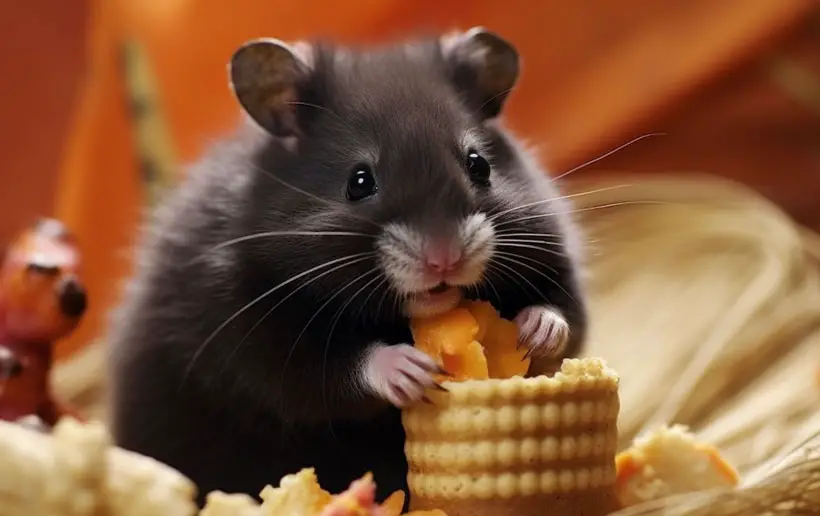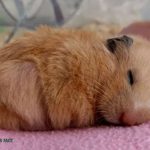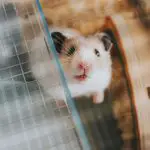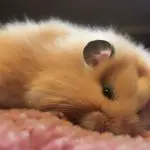Black Bear Hamster Care: Food, Habitat, Health, Tips and Facts
Black bear hamsters would easily make it on the list of first-time pet owners for their adorable and docile nature. That’s right, these furry black teddy bear hamsters are friendly and easy to handle, meaning they require moderate care level.
But what exactly does black bear hamster care entail? A balanced diet, sanitation, exercise, and proper health care form the backbone of your hamster care routine. Some bit of adjustments may be necessary to accommodate your hamster’s unique personality, preferences, and environment.
Read on as we unravel all you need to know about black bear hamster care. We’ll discuss matters of food, habitat, and health and also provide extra care tips and some interesting facts.
Food
What’s the ideal black bear hamster diet? A rough guideline would be commercial hamster pellets as the main staple. Supplement this with treats like veggies, fruits, and mealworms. The chart below breaks down the food requirement of a full-grown black bear hamster.

| Food Type | Amount | Frequency |
|---|---|---|
| Hay | Provide hay serving as hamster nesting material | 2-3 times per week |
| Commercial hamster pellets | Two tablespoons (nursing or pregnant mothers may eat more) | Daily |
| Treats (Fruits, veggies, and mealworms) | A teaspoon serving | 2-3 times per week |
- Accordingly, don’t forget to provide hay occasionally, preferably Timothy hay. Hay is desirable for its high-fiber content, that’s crucial for digestion.
- Also, a study on the importance of fiber concludes that fiber can prevent “wet tail” hamster disease.
- Pellet mix should be the staple for your black teddy bear hamster as it incorporates proteins, vitamins, and minerals, meeting all your hamster’s nutritional needs.
- However, you want to ensure that it doesn’t have too many seeds, nuts, or dried foods, as they’re high in sugar and may cause diarrhea.
- Supplement hamster pellets with fresh fruits and veggies 2-3 times a week.
- While at it, stick to safe options like leafy greens, carrots, and apples.
- Avoid citrus fruits due to their high acidity and grapes due to their high sugars.
- Be aware that hamsters like hoarding, always stuffing uneaten food in their mouth. So, ensure your hamster eats everything before refilling their food bowl.
- Incorporate fresh water into their diet. But instead of an open water bowl, use water bottles with drinking tubes to prevent contamination.
Habitat

Before we get into your hamster’s housing details, let’s first look at the ideal surrounding for a black teddy bear hamster.
- Primarily, you want a quiet place for your hamster and avoid heavily-lit spots near doors or windows so as not to disrupt their sleeping.
- Also, keep tabs on the temperature. For a hamster, you should be looking at a temperature range of 59°F to 77°F.
Housing Size
Now to the housing details. But first, let’s look at how large a black bear hamster can get. The full size of an adult is 5-6 inches, often weighing 4-6 ounces. So, what house size does it need?
- According to PDSA, a hamster cage should be at least 100x50cm (LxW).
- However, such a size is as good as it can get for the more active dwarf hamsters, not docile black bear hamsters. So if your space doesn’t allow for a 100x50cm cage, a good starting point would be 24 x 12 x 12 inches (LxWxH) or 3456 cubic inches.
Housing Type
Different hamster cages are up for sale. But which one should you buy?
- Instead of the open wire cage, we recommend a hamster cage and habitat combo. After all, it combines both the cage and the hamster’s hideouts and toys.

Moreover, this feature-packed hamster habitat includes toys like exercise wheels and climbing ladders. It will ultimately save you the headache of trying to figure out what to put in your hamster cage.
- In need of more space? No problem; you can connect a hamster module to your hamster cage and habitat. It’s more of a maze with options to add more tunnels and toys. This will give your hamster more ground to explore.
- These modules can be plastic or wire. We wouldn’t recommend plastic for hot areas since it tends to have poor circulation.
- A wire hamster module, on the other hand, isn’t safe if you have other predatory pets around. Cats, for instance, may try to paw in between the bars.
- In addition, you want to consider the spacing on the wire bars. They shouldn’t be too tight as to snag the long hairs of your black bear hamster. At the same time, they shouldn’t be too large as to allow cats to paw through them.
Habitat Enrichment

In fact, black teddy bear hamsters are more prone to obesity owing to their docile nature. Therefore, exercise gear and plenty of exploration will keep them active.
- In your choice of exercise wheel, avoid those with slats so your hamster doesn’t get caught in between the spaces.
- Ideally, you want a wheel size of at least 12 inches to prevent your hamster from arching when running.
- As far as bedding goes, you should be careful of your choice. Remember, bedding provides the ideal place for burrowing. Nevertheless, the question should be, which type of bedding do you need?
- Ideal bedding includes wood shavings, untreated sawdust, and shredded paper.
- However, shavings from woods like cedar and pine contain phenols. These oils may cause respiratory problems and other health issues like liver damage.
- Sawdust, on the other hand, can be very dusty, causing your hamster respiratory problems. So, the best option would be shredded paper because it’s super absorbent and safe.
Habitat Cleaning
- Practice routine cleaning of your hamster habitat.
- A good recommendation would be to spot-clean the cage daily and do a thorough wash weekly.
- This thorough wash would also include the toys and exercise gear.
- Also, swap out the bedding 1-2 times a week as urine, poop, moisture, and leftover food collect on it.
Health
As discussed earlier, the black bear hamster is more prone to obesity, considering its docile nature. Nevertheless, habitat enrichment will prevent such health issues.

- Also, dental care is important for black bear hamsters. The cheek teeth and incisors never cease to grow. So, it’s not uncommon for a hamster’s teeth to puncture the oral-nasal fistulas and cheek pouches. The result is usually ulcers and a painful collection of pus under the cheek skin.
- You can always prevent this dental issue with natural wood chew toys and hard dog biscuits.
- These will help wear down the teeth to prevent overgrowth. Also, make it a routine to check their teeth for any signs of uneven wear.
Black bear hamsters suffer from other ailments. Here are the common ailments and preventive care.
| Black Bear Hamster Disease | Preventive Care |
|---|---|
| Wet tail | Proper sanitation, a balanced diet, and stress reduction |
| Diabetes | Proper diet and medication |
| Cancer | A balanced diet, a clean cage, and plenty of exercises |
| Avoid exposure to carcinogens like tobacco smoke and household cleaners | |
| Bladder stones | Ensure clean, fresh water to prevent dehydration that causes bladder stones |
| Salmonellosis | Keep the cage clean and wash your hands before handling your hamster |
Importance of Veterinary Care
- Regular vet checkups will allow for early detection, prevention, and treatment of hamster diseases.
- Also, upon buying your black bear hamster, get it examined within 48 hours.
- You should also monitor your hamster’s health and behavior in between vet checkups to catch any signs of illness.

Giving Medication
Black teddy bear hamsters are small animals. Hence, it can be quite easy to overdose. As such, follow your vet’s instructions regarding the correct dosage.
Moreover, hamsters are sensitive to antibiotics. So, avoid giving antibiotic treatment unless advised by the vet. Antibiotics like ampicillin, penicillin, and streptomycin may disrupt the microbial balance in your hamster’s gastrointestinal tract, often leading to an overgrowth of bad bacteria.
Extra Care Tips
Here are some additional tips to help you care for your black bear hamster:
- Give your hamster a haircut if the hair becomes matted or tangled. You may also take preventative measures by brushing it weekly
- Spend at least 30 minutes daily interacting with your hamster, handling them carefully
- Avoid using scented products near the cage as they can irritate your hamster’s respiratory system
- Avoid feeding seeds with husks to avoid damage to the delicate cheek pouch lining
- Don’t feed high-moisture foods as they can cause diarrhea or constipation
- When choosing hamster toys and accessories, look for items labeled BPA-free to ensure their safety

Black Bear Hamster Interesting Facts
- The black bear hamster is yet to be classified as a true hamster breed. Some consider it a subtype of the teddy bear Syrian hamster
- It goes by other names like a black teddy bear
- Black bear hamsters are renowned for their docile temperament
- A black bear hamster’s life span is 2-3 years
- It sheds more than other hamsters
- Males have longer fur than females
- They have black coloration with some white markings that resemble an actual black bear
- The black fur turns brown as they age
FAQs
We’ll highlight and provide answers to a few common questions regarding black bear hamster care.
Q: How do I make teddy bear hamsters happy?
Provide them with plenty of toys and exercise, a clean and comfortable cage, and a balanced diet. Also, spare some time to interact with them.
Q: Do black bear hamsters like to be alone?
Black bear hamsters may be aggressive in the presence of other hamsters and prefer to live in their own cage. However, you can spend time interacting with them for mental stimulation and socialization.
Q: Are black Syrian hamsters rare?
No. Although not as common as other coat variations like Golden, the black Syrian hamster isn’t considered rare. You’ll find black Syrian hamsters for sale in many pet stores and breeders.
Conclusion
Black bear hamsters are adorable and easy-going hamsters. Compared to other hamsters, they need moderate care, making them an ideal pet for even inexperienced owners. Essentially, a balanced diet, clean living conditions, affection, and health care will make them happy.
Also, being docile, you should pay more attention to providing them with more exercise opportunities to avoid obesity. And don’t forget to brush them or give them a haircut for a well-groomed, shiny coat.




